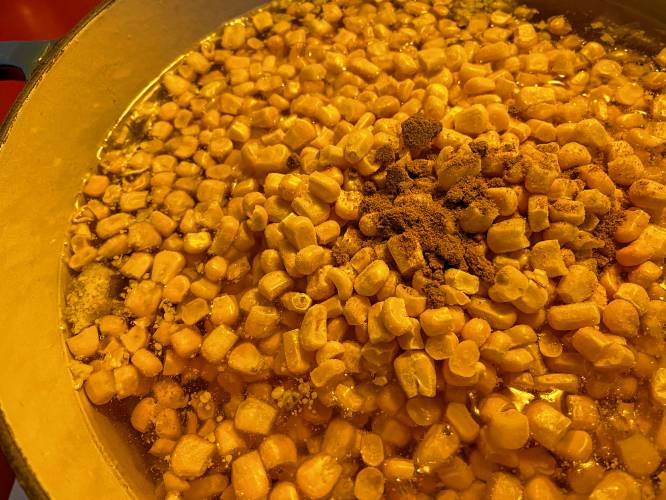Replicable yet flexible: For National Soup Month, a simple recipe that will never steer you wrong
|
Published: 01-23-2024 2:59 PM
Modified: 01-23-2024 4:58 PM |
January is National Soup Month so I thought for this week I would make one of my favorite soups and share the story of its origins.
Some home cooks don’t write down recipes at all. I was one of those cooks before I became a food writer. I would combine ingredients based on whim and intuition. Usually, the results were tasty; I have a good sense of what flavors go together.
However, the results were never replicable. If I wanted to make a dish again exactly as I had made it the first time, I was out of luck.
Once I started writing about food, replicable results became crucial. Readers don’t mind the occasional “add this ingredient to taste.” They do object to a recipe that consists of nothing but amounts to taste, and rightly so.
It took me a while to develop the habit of writing down exact amounts of my ingredients. Even today, I occasionally dollop an extract or sprinkle an herb with abandon and then must make myself reconstruct the process. Nevertheless, I generally manage to write down the amounts I use before I forget them.
Unexpectedly but fortunately, my learned habit of writing down recipe quantities has increased rather than squelched my tendency to improvise in the kitchen. If I know exactly what went into a version of a dish, I can compare it more accurately with an alternative version.
I consequently tend to adapt recipes frequently. The soup I’m featuring today, which I remade last week, is a case in point. It is heavily adapted from a recipe that appeared in the book “Herbal Soups” by Ruth Bass, put out in 1996 by Storey Publishing. I think I reviewed the book for this newspaper.
Ruth was my editor when I wrote about food, books, and odds and ends for the Berkshire Eagle in the 1990s. She still writes for that paper on occasion, but she prefers writing to editing. We had similar sensibilities about food and life, and I enjoyed working with her. I also enjoyed her short, simple cookbooks.
Article continues after...
Yesterday's Most Read Articles
 My Turn: Quabbin region will never see any benefits from reservoir
My Turn: Quabbin region will never see any benefits from reservoir
 As I See It: Between Israel and Palestine: Which side should we be on, and why?
As I See It: Between Israel and Palestine: Which side should we be on, and why?
 New USDA offices in Greenfield to aid staffing increase, program expansion
New USDA offices in Greenfield to aid staffing increase, program expansion
 Longtime Orange public servant Richard Sheridan dies at 78
Longtime Orange public servant Richard Sheridan dies at 78
 Retired police officer, veteran opens firearms training academy in Millers Falls
Retired police officer, veteran opens firearms training academy in Millers Falls
 Four Rivers boys knock off Xaverian to win Four Rivers Ultimate Tournament on Saturday (PHOTOS)
Four Rivers boys knock off Xaverian to win Four Rivers Ultimate Tournament on Saturday (PHOTOS)
I have no idea where my copy of “Herbal Soups” has gone, but I make a version of one of its recipes frequently. Ruth flavored a late-summer corn and tomato soup with basil. She then blended the mixture into a brightly colored (and flavored) puree.
I have a vague recollection that Ruth added a little milk or cream sauce to her soup and maybe some cheese, although I can’t say for sure. It has been a couple of decades since I saw the original recipe.
I don’t think I ever used the sauce, although I did serve the soup with grated cheddar on the side when I entertained.
As the years went by, I tried a minor adaptation and switched seasons.
Instead of using fresh tomatoes and corn in late summer, I turned to canned tomatoes and frozen corn in winter. The result was barely distinguishable from the original.
Next, I waxed bolder and altered the flavor profile of the soup to create a slightly Southwestern recipe. I changed the herb from basil to cilantro and added the sort of ingredients one finds in a good salsa fresca: bell peppers, jalapeños, and lots of onion and garlic.
My most recent change to the recipe came when I realized that I didn’t need to shop for all those individual salsa ingredients. Last week, I decided to use good-quality canned salsa, either homemade or store bought, in place of the tomatoes in the original recipe. I did add a little extra cumin. I love cumin.
I should warn you that it is important to make sure that you like the salsa you’re using — and are comfortable with its level of heat — before preparing this soup.
If you’re leery of spicy food, stick with straight canned tomatoes and then add cilantro, peppers, onion, and garlic to your taste.
I used a commercial, organic medium-hot salsa. The soup was a huge hit when I took it to a pot luck. When I ate leftovers by myself, I eschewed the garnishes. My friends found them delightful, however. Happily, the sour cream managed to tone down the spice factor for anyone who objected to heat.
I should add that the recipe is flexible. If you toss in more corn than salsa or vice versa, it will still be delicious. If you’re serving a crowd, feel free to double the quantities listed, as I did last week.
Ingredients:
for the soup:
2 cups frozen corn
2 cups salsa
1 quart chicken or vegetable broth (even water will do; the soup has plenty of flavor)
salt and pepper to taste (how much salt depends on how salty your broth and salsa are; it may not be needed at all)
1 teaspoon cumin seeds, whole or ground
optional garnishes:
sour cream or Greek yogurt (just a little bit makes the soup creamy)
grated store (Cheddar) cheese
tortilla crisps (corn tortillas cut into small strips and fried briefly in canola oil and then drained on paper towels)
Instructions:
In a large pot, combine the soup ingredients. Bring the soup to a boil; then reduce the heat and simmer, covered, until the vegetables are tender (about 30 minutes). Your kitchen will smell like summer.
Cool the soup slightly, and puree it using a blender. I saved clean-up time by using my immersion blender, but I realize not everyone has one of those. Any blender — even a food processor — will do.
Serve with or without the garnishes. Serves 6 to 8.
Tinky Weisblat is an award-winning cookbook author and singer known as the Diva of Deliciousness. Visit her website, TinkyCooks.com.




 Speaking of Nature: Indulging in eye candy: Finally, after such a long wait, it’s beginning to look like spring is here
Speaking of Nature: Indulging in eye candy: Finally, after such a long wait, it’s beginning to look like spring is here Celebrating ‘Seasonings’: New book by veteran preacher and poet, Allen ‘Mick’ Comstock
Celebrating ‘Seasonings’: New book by veteran preacher and poet, Allen ‘Mick’ Comstock Faith Matters: How to still the muddy waters of overthinking: Clarity, peace and God can be found in the quiet spaces
Faith Matters: How to still the muddy waters of overthinking: Clarity, peace and God can be found in the quiet spaces A time for every purpose under heaven: Free sing-a-long Pete Seeger Fest returns to Ashfield, April 6
A time for every purpose under heaven: Free sing-a-long Pete Seeger Fest returns to Ashfield, April 6
